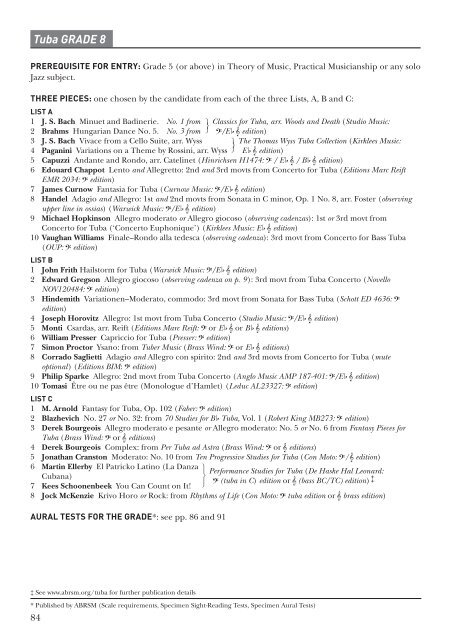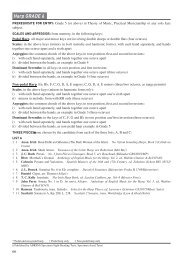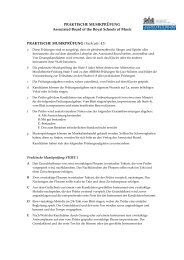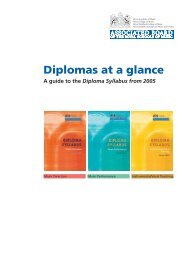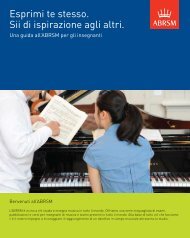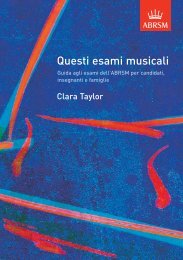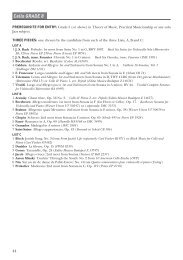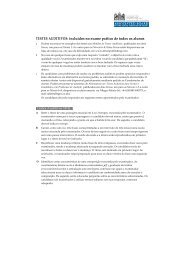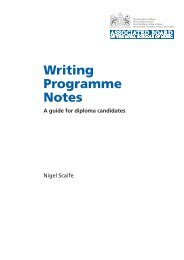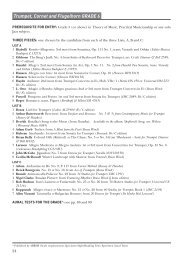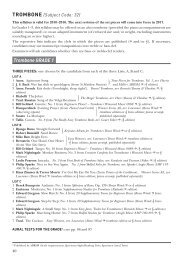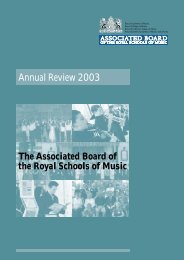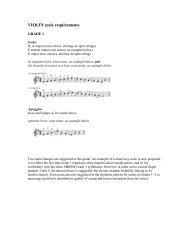Create successful ePaper yourself
Turn your PDF publications into a flip-book with our unique Google optimized e-Paper software.
<strong>Tuba</strong> <strong>GRADE</strong> 8<br />
PREREQUISITE FOR ENTRY: Grade 5 (or above) in Theory of Music, Practical Musicianship or any solo<br />
Jazz subject.<br />
THREE PIECES: one chosen by the candidate from each of the three Lists, A, B and C:<br />
LIST A<br />
1 J. S. Bach Minuet and Badinerie. No. 1 from ¸ Classics for <strong>Tuba</strong>, arr. Woods and Death (Studio Music:<br />
˝<br />
2 Brahms Hungarian Dance No. 5. No. 3 from ˛ ? /E b & edition)<br />
3 J. S. Bach Vivace from a Cello Suite, arr. Wyss ¸ The Thomas Wyss <strong>Tuba</strong> Collection (Kirklees Music:<br />
˝<br />
4 Paganini Variations on a Theme by Rossini, arr. Wyss ˛ E b & edition)<br />
5 Capuzzi Andante and Rondo, arr. Catelinet (Hinrichsen H1474: ? / E b & / B b & edition)<br />
6 Edouard Chappot Lento and Allegretto: 2nd and 3rd movts from Concerto for <strong>Tuba</strong> (Editions Marc Reift<br />
EMR 2034: ? edition)<br />
7 James Curnow Fantasia for <strong>Tuba</strong> (Curnow Music: ? /E b & edition)<br />
8 Handel Adagio and Allegro: 1st and 2nd movts from Sonata in C minor, Op. 1 No. 8, arr. Foster (observing<br />
upper line in ossias) (Warwick Music: ? /E b & edition)<br />
9 Michael Hopkinson Allegro moderato or Allegro giocoso (observing cadenzas): 1st or 3rd movt from<br />
Concerto for <strong>Tuba</strong> (‘Concerto Euphonique’) (Kirklees Music: E b & edition)<br />
10 Vaughan Williams Finale–Rondo alla tedesca (observing cadenza): 3rd movt from Concerto for Bass <strong>Tuba</strong><br />
(OUP: ? edition)<br />
LIST B<br />
1 John Frith Hailstorm for <strong>Tuba</strong> (Warwick Music: ? /E b & edition)<br />
2 Edward Gregson Allegro giocoso (observing cadenza on p. 9): 3rd movt from <strong>Tuba</strong> Concerto (Novello<br />
NOV120484: ? edition)<br />
3 Hindemith Variationen–Moderato, commodo: 3rd movt from Sonata for Bass <strong>Tuba</strong> (Schott ED 4636: ?<br />
edition)<br />
4 Joseph Horovitz Allegro: 1st movt from <strong>Tuba</strong> Concerto (Studio Music: ? /E b & edition)<br />
5 Monti Csardas, arr. Reift (Editions Marc Reift: ? or E b & or B b & editions)<br />
6 William Presser Capriccio for <strong>Tuba</strong> (Presser: ? edition)<br />
7 Simon Proctor Ysano: from Tuber Music (Brass Wind: ? or E b & editions)<br />
8 Corrado Saglietti Adagio and Allegro con spirito: 2nd and 3rd movts from Concerto for <strong>Tuba</strong> (mute<br />
optional) (Editions BIM: ? edition)<br />
9 Philip Sparke Allegro: 2nd movt from <strong>Tuba</strong> Concerto (Anglo Music AMP 187-401: ? /E b & edition)<br />
10 Tomasi Être ou ne pas être (Monologue d’Hamlet) (Leduc AL23327: ? edition)<br />
LIST C<br />
1 M. Arnold Fantasy for <strong>Tuba</strong>, Op. 102 (Faber: ? edition)<br />
2 Blazhevich No. 27 or No. 32: from 70 Studies for B b <strong>Tuba</strong>, Vol. 1 (Robert King MB273: ? edition)<br />
3 Derek Bourgeois Allegro moderato e pesante or Allegro moderato: No. 5 or No. 6 from Fantasy Pieces for<br />
<strong>Tuba</strong> (Brass Wind: ? or & editions)<br />
4 Derek Bourgeois Complex: from Per <strong>Tuba</strong> ad Astra (Brass Wind: ? or & editions)<br />
5 Jonathan Cranston Moderato: No. 10 from Ten Progressive Studies for <strong>Tuba</strong> (Con Moto: ? /& edition)<br />
6 Martin Ellerby El Patricko Latino (La Danza<br />
Performance Studies for <strong>Tuba</strong> (De Haske Hal Leonard:<br />
Cubana)<br />
? (tuba in C) edition or & (bass BC/TC) edition) ‡<br />
¸<br />
˝<br />
7 Kees Schoonenbeek You Can Count on It! ˛<br />
8 Jock McKenzie Krivo Horo or Rock: from Rhythms of Life (Con Moto: ? tuba edition or & brass edition)<br />
AURAL TESTS FOR THE <strong>GRADE</strong>*: see pp. 86 and 91<br />
‡ See www.abrsm.org/tuba for further publication details<br />
* Published by <strong>ABRSM</strong> (Scale requirements, Specimen Sight-Reading Tests, Specimen Aural Tests)<br />
84
<strong>Tuba</strong> <strong>GRADE</strong> 8<br />
SCALES AND ARPEGGIOS*: from memory, to be played slurred, legato-tongued and staccato in the following<br />
keys:<br />
Bass clef E b <strong>Tuba</strong>: E, F, F # , G, Ab majors; E, F, F # , G, G # minors (a twelfth)<br />
All other keys, major and minor (two octaves)<br />
Bass clef F <strong>Tuba</strong>: F # , G, Ab, A, Bb majors; F # , G, G # , A, Bb minors (a twelfth)<br />
All other keys, major and minor (two octaves)<br />
Bass clef B b <strong>Tuba</strong>: B, C, Db, D, Eb majors; B, C, C # , D, Eb minors (a twelfth)<br />
All other keys, major and minor (two octaves)<br />
Treble clef (all <strong>Tuba</strong>s) and bass clef C <strong>Tuba</strong>: Db, D, Eb, E, F majors; C # , D, Eb, E, F minors (a twelfth)<br />
All other keys, major and minor (two octaves)<br />
Scales: in the above keys (minors in both harmonic and melodic forms)<br />
Chromatic Scales: Bass clef E b <strong>Tuba</strong>: starting on any note A–Eb (two octaves)<br />
Bass clef F <strong>Tuba</strong>: starting on any note B–F (two octaves)<br />
Bass clef B b <strong>Tuba</strong>: starting on any note E–Bb (two octaves)<br />
Treble clef (all <strong>Tuba</strong>s) and bass clef C <strong>Tuba</strong>: starting on any note F # –C (two octaves)<br />
Whole-Tone Scales: Bass clef E b<strong>Tuba</strong>: starting on D and Eb (two octaves)<br />
¸<br />
Bass clef F <strong>Tuba</strong>: starting on E and F (two octaves)<br />
Ó<br />
as example given<br />
Bass clef B b <strong>Tuba</strong>: starting on A and Bb (two octaves) Ï below<br />
Treble clef (all <strong>Tuba</strong>s) and bass clef C <strong>Tuba</strong>: starting on B and C (two octaves) ˛<br />
Arpeggios: the common chords of the above keys for the ranges indicated<br />
Dominant Sevenths: Bass clef E b <strong>Tuba</strong>: in the keys of D, Eb, E, F, F # , G and Ab (two octaves)<br />
Bass clef F <strong>Tuba</strong>: in the keys of E, F, F # , G, Ab, A and Bb (two octaves)<br />
Bass clef B b <strong>Tuba</strong>: in the keys of A, Bb, B, C, Db, D and Eb (two octaves)<br />
Treble clef (all <strong>Tuba</strong>s) and bass clef C <strong>Tuba</strong>: in the keys of B, C, Db, D, Eb, E and F (two octaves)<br />
Diminished Sevenths: Bass clef E b<strong>Tuba</strong>: starting on B, C and Db (two octaves)<br />
Bass clef F <strong>Tuba</strong>: starting on Db, D and Eb (two octaves)<br />
Bass clef B b <strong>Tuba</strong>: starting on F # , G and Ab (two octaves)<br />
Treble clef (all <strong>Tuba</strong>s) and bass clef C <strong>Tuba</strong>: starting on Ab, A and Bb (two octaves)<br />
SIGHT-READING*: (bass or treble clef at candidate’s choice) see p. 7.


